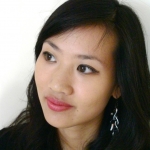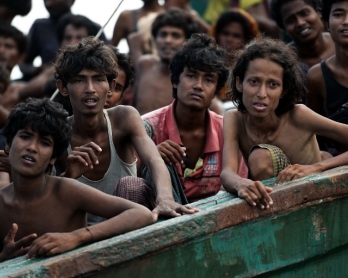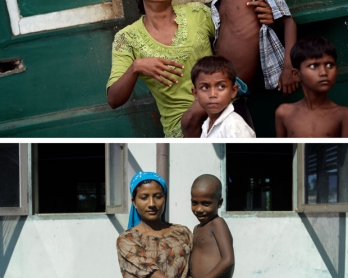An indelible mark
Covering the Rohingya exodus into Bangladesh left an indelible mark on AFP journalists Agnes Bun and Sam Jahan. For Agnes, the assignment suddenly became personal -- as she filmed the desperate tide of humanity fleeing, she pictured her family doing the same decades earlier, escaping the Cambodian genocide. Sam was struck by the children -- a soaking wet toddler all alone, a little girl terrified of a camera tripod, a small boy trying to save his mother. He couldn’t bear seeing such tiny lives shattered so utterly. Here they recount their stories.
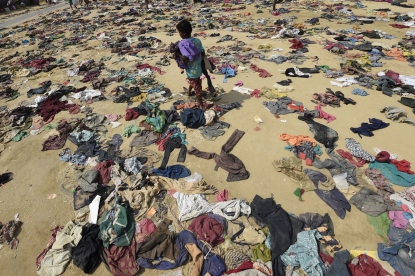 A Rohingya Muslim boy walks past discarded clothing on the ground at the Bhalukali refugee camp near Ukhia on September 16, 2017.
(AFP / Dominique Faget)
A Rohingya Muslim boy walks past discarded clothing on the ground at the Bhalukali refugee camp near Ukhia on September 16, 2017.
(AFP / Dominique Faget)Killing me inside
By Sam Jahan
Cox’s Bazar, Bangladesh -- The phone rang at 4 am. It was Kamal, a Rohingya man whom I met last fall during the Rohingya exodus to Bangladesh who was living near Cox’s Bazar, a fishing port not far from the Myanmar border.
"Assalamu Alaykum Kamal bhai, what's up?" I said in a sleepy voice.
"Sir! They are burning everything... killing us randomly. I'm going to Burma to bring my relatives. Please let the world know about this oppression and pray for us!" he said, panting. He seemed to be running.
He then hung up. I haven’t heard a word from him since.
The phone call left me wide awake. I knew the Myanmar army had been gathering in the Rakhine region for the past few days and that scores of Rohingya were arriving at the border of Bangladesh, despite repeated denials from border and coast guards.
I was supposed to be home for a week of bed rest because of severe back pain. But after Kamal’s phone call, I literally begged my office to let me go to Cox’s Bazar on a reporting mission. I knew enough of the story to realize that something big was brewing. Whenever the Myanmar army conducted operations in the Rahine state, it resulted in scores of Rohingya fleeing and international accusations that the government forces were engaging in ethnic cleansing of the Muslim minority people living in the Buddhist-majority country.
The begging paid off and my bosses agreed to let me go after our Yangon bureau filed the news that Rohingya insurgents had struck Burmese military posts, an attack that was sure to lead to a tough response.
I flew to Cox's with my notebook, tape recorder, camera, tripod and a bag full of painkillers.
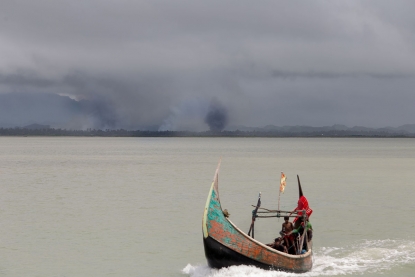 This photograph taken on September 12, 2017 shows Rohingya refugees arriving by boat, as smoke rises from fires on the shoreline behind them, at Shah Parir Dwip on the Bangladesh side of the Naf River after fleeing violence in Myanmar. (AFP / Adib Chowdhury)
This photograph taken on September 12, 2017 shows Rohingya refugees arriving by boat, as smoke rises from fires on the shoreline behind them, at Shah Parir Dwip on the Bangladesh side of the Naf River after fleeing violence in Myanmar. (AFP / Adib Chowdhury)We couldn’t see anything happening on the first day, despite my local sources telling me that Rohingya came near the border overnight but were denied entry into Bangladesh. Trying to get more information, I headed to a border guard outpost in a frontier area called Ghumdhum to meet with a commander.
The gentleman was very cooperative. He allowed me to film our interview, during which he said that the situation was calm and quiet. As soon as I turned off the record button, as if on cue, hundreds of rounds of gunshots erupted on the other side of the border, nearly a kilometer away. Mortar shells dropped intermittently into the ditches inside the no-man’s land, sending up splashes of 15-20 meters high. I saw thousands of people, who had been hiding in the hills, running for their lives toward the border.
I've never seen anything so astounding before. I was intimidated, excited, angry and above all very curious. This was the first time that I was witness to such a thing. I had covered the Holey Artisan bakery massacre in Dhaka the previous year, which left 29 people dead. But I didn’t see it happening as it unfolded. But this, this was happening before my own eyes.
The commander ordered his men to be ready for any emergencies and sent dozens of personnel to the border posts and trenches. These men allowed the Rohingya to come closer to the Bangladesh border, though they didn’t allow them to enter the country. “At least we can let them come closer so that they are safe from the mortars’ range,” the commander said.
As I filmed the fleeing refugees in the distance, kicking myself for not having brought a bigger lens, the commander approached me, asking me to re-interview him.
He seemed to be emotional and made a bold statement for a government official. “We can see great numbers of refugees coming down from the hills, mostly women and children. We hear heavy firing from a Burmese post, but we cannot see exactly what is happening. The situation seems very tense and we are on the highest alert.”
By the next day, the world knew of the atrocities that were reported in the Rohingya villages. Having run away, scores of them were now stranded inside Bangladesh. The next morning I rushed to the same spot. The Bangladesh border officers were guarding at least 500 Rohingyas who managed to cross. I was mesmerized. They were all women, children and old men. Sitting under the scorching sun after being drenched by the monsoon ...
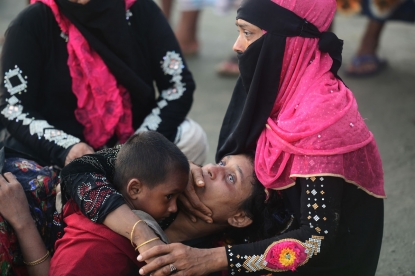 Relatives of a Rohingya refugee comfort her after crossing the border from Myanmar by boat, on the Bangladeshi shore of the Naf river in Teknaf on September 14, 2017. (AFP / Munir Uz Zaman)
Relatives of a Rohingya refugee comfort her after crossing the border from Myanmar by boat, on the Bangladeshi shore of the Naf river in Teknaf on September 14, 2017. (AFP / Munir Uz Zaman)A little girl snatched my attention; I learned her name was Fatima. The three-year-old was roaming in the meadow, playing with an empty plastic water bottle and trying to hug it, but it was bigger than her embrace. I wanted to film it, so I started to set up my tripod, unfolding its legs.
Fatima noticed me doing this. Stunned, she stopped moving and stood perfectly still as I set up the tripod.
When I put my eye to the viewfinder to focus, she suddenly started screaming and looking around for her mother. I was bewildered. What was wrong? I couldn’t understand what she was screaming. She kept repeating the same words over and over. Eventually I could make sense of it. She was saying: “Oh mother look! He's going to shoot me with the gun!"
I was shocked. A three-year-old was thinking that I pointed a gun on her! What could she have seen in her 1,000 days on this earth to think such a thing?
I pulled away from the tripod, trying to calm her down. She ran behind a tree, hiding behind her five-year-old sister Amina.
Her mother Mokhlesa, a widowed mother of five, came toward her. She tried to calm her daughter down. She explained to me why she had reacted so. The toddler was traumatised because just days before, she saw her father killed before her eyes.
"She saw her father's death when soldiers shot him dead at point blank range,” the mother told. Me. “She has nightmares about it every night.” I did not know what to say…
 A Rohingya refugee from Myanmar's Rakhine state holds a baby after arriving at a refugee camp near the Bangladeshi town of Teknaf on September 5, 2017. (AFP / K M Asad)
A Rohingya refugee from Myanmar's Rakhine state holds a baby after arriving at a refugee camp near the Bangladeshi town of Teknaf on September 5, 2017. (AFP / K M Asad)Since then, I've been trying to dig out more stories of these unfortunate child refugees who have seen what they shouldn't have seen. Hundreds of thousands of Rohingya children have arrived in Bangladesh and are living on the roadsides and hills in dire need of safe water, food and shelter. I wished that I could help them all, but I had my limitations. I knew that if I gave something to one person, it could touch off a mob, because everyone was so needy. They had nothing.
My driver Siddik had an encounter with a little Rohingya boy who came near our car during a downpour and asked: "Hey uncle! Could you please give me some money to buy a kilo of rice. My mother is sick and I left her on the hill." I secretly passed 50 taka to Siddik telling him to give it to the boy. The kid took the money and was blankly looking at it as he didn't recognise the Bangladeshi currency. He asked again: "Will it be enough to buy some rice?" I asked him what happened to his mother. He said she was suffering from diarrhea. No wonder.
The refugees were defecating in the open, as they didn't have many options, and were drinking water from literally anywhere. An epidemic seemed inevitable and soon, God forbid. Most of the infants and toddlers already had pneumonia and cough-related illnesses due to the constant change between rain and sun. They needed emergency medical assistance. I gave the boy my entire supply of diarrhea medicine and oral salines for his mother. But deep inside, I knew, he still wouldn’t be able to find sufficient drinking water.
The next day, I went to the southernmost tip of Bangladesh mainland called Shah Porir Dwip, where Rohingya refugees were still arriving by boats and scores of bodies floated ashore. The seasonal rains were drenching everyone that day. The refugees were embarking on trucks, heading towards the camps where some relief and assistance were available.
I saw a little two-year-old Rohingya girl... She was silently sitting on an open-back truck, shivering. Raindrops drenched her but she didn't know what to do. I put my hands on her forehead to check the temperature and felt that she was burning with a fever. I asked the people on board whether she had her parents or relatives who could take care of her and shield her from the rain. A man sitting next to her bluntly said she was an orphan.
I felt so helpless. I couldn’t stop myself from breaking down in tears. Something was killing me inside. I have deeply felt for all of the kids that I had seen, but this orphaned baby girl touched me like no other. She was so little and seemed so lonely. Someone had the mercy to put her on the truck and bring her to Bangladesh, away from the atrocities being reported in her home, but now she was on her own in a foreign land. I had enough of seeing these children undergoing these harrowing plights. It was too much for me. I felt I was on the verge of a nervous breakdown.
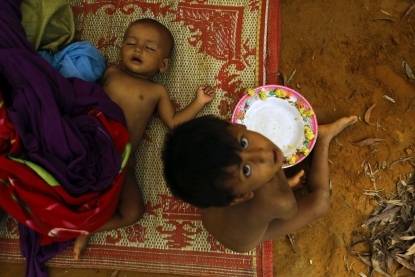 Rohingya refugees from Myanmar's Rakhine state shelter in a makeshift tent after arriving at a refugee camp near the Bangladeshi town of Teknaf on September 5, 2017.
(AFP / K M Asad)
Rohingya refugees from Myanmar's Rakhine state shelter in a makeshift tent after arriving at a refugee camp near the Bangladeshi town of Teknaf on September 5, 2017.
(AFP / K M Asad)I understand of course that a lot goes on when you cover such a crisis. I tried to cope with everything as best as I could and eventually I wanted to forget it. But fate had a few more scars to inflict on me. I met Azizul, a 15-year-old boy and victim of a landmine.
He lost both his legs and most of his abdomen due to an anti-personnel landmine explosion. When we went to see him at a hospital, he was drifting in and out of consciousness. Whenever he would come to, he would weakly scream: "Oh mother! Bring me some juice... I will get you the money when I'll grow up and earn a living." His penniless mother could only helplessly shed tears and try to comfort her dying son.
I wrote a story about Azizul which was published on the wire next morning. I called the hospital authorities to check how the little man was doing. Azizul was no more...
As with any other humanitarian crisis, there are politics involved. We journalists try to cover what’s happening as best we can. I have returned home now from my mission. But I keep wondering what all of those kids that I wrote about are doing now, whether they’re alive and safe.
Collateral damage is inevitable in any conflict, I understand that. But I just can’t get over all the grief that I saw, especially the children suffering. I managed to take care of my physical pain with medicine, but I wonder what painkillers will heal my mind after what I've witnessed these days.
This blog was written with Yana Dlugy in Paris
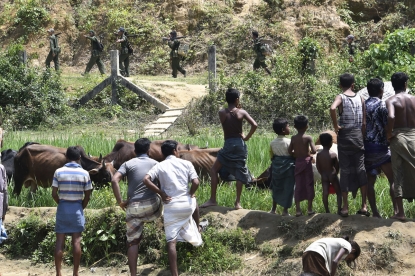 Rohingya Muslim refugees in Jalpatoli refugee camp in the no-man's land area between Myanmar and Bangladesh watch as Myanmar soldiers patrol on the other side of the border, near Gumdhum village in Ukhia on September 16, 2017. (AFP / Dominique Faget)
Rohingya Muslim refugees in Jalpatoli refugee camp in the no-man's land area between Myanmar and Bangladesh watch as Myanmar soldiers patrol on the other side of the border, near Gumdhum village in Ukhia on September 16, 2017. (AFP / Dominique Faget)This time it's personal
By Agnes Bun
Cox’s Bazar, Bangladesh -- I will remember his cries of pain for the rest of my life.
Azizul was fifteen years old. A Rohingya refugee, he was crossing the border between Myanmar and Bangladesh with his parents, his brother and his two sisters when he stepped on a landmine. He arrived in Bangladesh with his legs blown away, to die later in a hospital bed, surrounded by other Rohingya refugees, who had to risk their lives as well in order to get to safety.
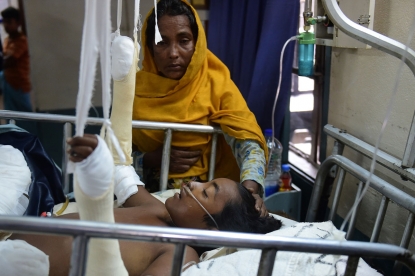 Azizul Hoque, 15, in a hospital with him mother, September 13, 2017.
(AFP / Munir Uz Zaman)
Azizul Hoque, 15, in a hospital with him mother, September 13, 2017.
(AFP / Munir Uz Zaman)More than forty years ago, my family also crossed borders to escape from the Cambodian genocide during the late 1970s. Some died. Others were tossed around from one labour camp to another. Others ended in refugee camps in Thailand and Vietnam, where they spent several years.
My parents eventually made their way to France, where they met, married and had me. A video journalist for Agence France-Presse, I have covered a typhoon, a war zone, an earthquake, and floods. Each catastrophe has left a lasting mark on me, the kind of pain that crushes you inside and leaves you in tears as you recall the faces that you’ve filmed.
But none of them compare to the Rohingya refugee crisis that I spent a week filming. This time it was personal. These entire families uprooted from their homes, with terror, emptiness, or a lack of understanding in their eyes in the face of the hatred that suddenly struck them -- these families were going through what mine endured less than half a century ago.
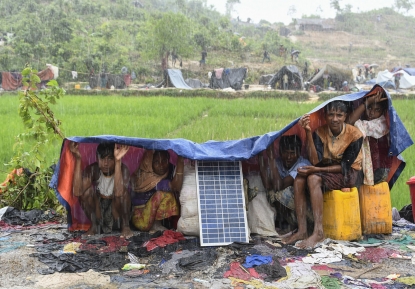 Rohingya refugees protect themself from the rain in Bangladesh's Balukhali refugee camp on September 17, 2017. (AFP / Dominique Faget)
Rohingya refugees protect themself from the rain in Bangladesh's Balukhali refugee camp on September 17, 2017. (AFP / Dominique Faget)For the first time in my life, history lent me a mirror in which I could look at my family history, the one I grew up with as told in my native Chinese dialect.
I point my camera at the scores of unaccompanied children in the Rohingya refugee camps, half naked, crying, throwing up, children who lost their parents during their escape or saw them killed right in front of their eyes, instantly stripped of their innocence. I film them and my mind wanders to the killing fields of Cambodia. Did my uncles and aunts look like that when they stumbled, some barely teenagers, over the border into Thailand, after having witnessed the death of friends and relatives and experienced starvation in the labour camps?
I film the Rohingyas and realise all that had been left unsaid by my family about our experience.
My relatives never told me about these elders whose wrinkled faces would brutally crumple, whose shoulders would sink along with their dignity as they recalled their homes and the lives that were burnt, destroyed by human barbarism.
Or this thick mud in which refugees have to waddle through during this monsoon season, mixed with human feces, because of a lack of toilets in the makeshift camps that keep swallowing, fed by the increasing number of exiles.
Or this permanent chaos, which is such that sometimes refugees are killed by speeding vehicles; an old man got hit by a truck under my eyes and collapsed, his head covered in blood. My colleagues and I chased the guilty truck with our car, jotted down its plate number and immediately communicated it to the police, who said they would follow up… I have little faith.
In the oldest camps, I met with Rohingya refugees who set up here in the 1990s. Some were even born in these places, and never saw anything else. Today they are teenagers or young adults, working menial jobs without any dream of yearn for the outside world.
I am myself the child of refugees, but there is a chasm between them and me. I doubt they will ever go to school, never mind to a university. I also crossed path with many pregnant women, with a life still growing inside them, yet already doomed.
During the week I spent in Bangladesh, I filmed as much as I could, to show the world what happens when man’s folly throws on the road hundreds of thousands of lives and alters them forever.
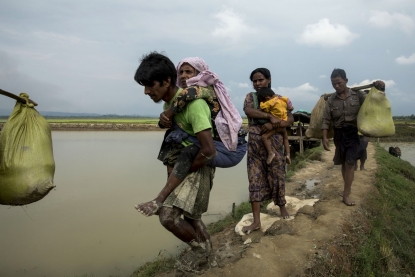 Displaced Rohingya refugees from Rakhine state in Myanmar walk near Ukhia, at the border between Bangladesh and Myanmar, as they flee violence on September 4, 2017. (AFP / K.m. Asad)
Displaced Rohingya refugees from Rakhine state in Myanmar walk near Ukhia, at the border between Bangladesh and Myanmar, as they flee violence on September 4, 2017. (AFP / K.m. Asad)I have not personally experienced the Cambodian genocide -- my parents both managed to escape just before, though grandparents and siblings got stuck inside, moving from one labor camp to another before eventually escaping to Thailand and Vietnam and from there emigrating to the US and New Zealand. But the genocide keeps having an impact on my life and choices, including my pick of a profession.
My father and mother seldom talked about what they and their family experienced all those years ago. There was no taboo attached to it, but these were events from the past, that were best left unstirred. As a teenager, I pieced their few stories together with what I read in books about the Cambodian genocide. I was of course nauseated to read of the horrors. But not until I saw the Rohingyas did it truly hit home – this was my family all those years back.
So as I filmed this time, it was partly for myself, a daughter of survivors, and for my family -- for my father who died too soon, who maybe would have been proud of my efforts to raise awareness about a story so similar to ours, on the other side of the world. Or maybe he would have been horrified to see his daughter immerse herself in a tragedy so close to the one he always tried to shield me from.
This I will never know. All I am sure of is that I will always carry in me the cry of Azizul, as an echo of the genocide that shaped my life before I was even born.
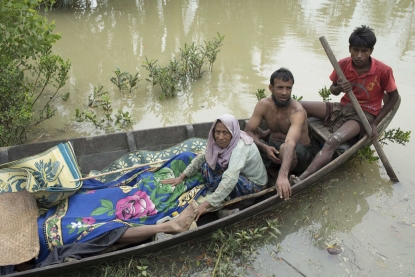 The bodies of Rohingya refugee are brought to shore on a boat by fellow Rohingyas after being recovered on the Naf river, as scores of refugees tried to flee from Myanmar to Bangladesh, near Ulubunia in Ukhiya on September 6, 2017. (AFP / K M Asad)
The bodies of Rohingya refugee are brought to shore on a boat by fellow Rohingyas after being recovered on the Naf river, as scores of refugees tried to flee from Myanmar to Bangladesh, near Ulubunia in Ukhiya on September 6, 2017. (AFP / K M Asad)


